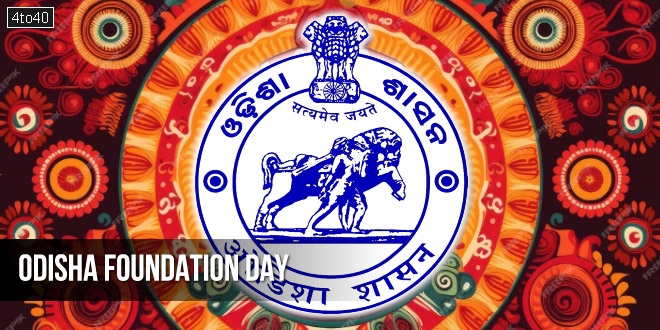Odisha Foundation Day: It is observed on 1 April. It is also known as Utkala Dibasa. On April 1, 1936, the Odisha became a separate province. Let us read more about Odisha Foundation Day.
Odisha Foundation Day (Utkala Dibasa):
Odisha Foundation Day 2025: Today, Odisha celebrates the 88th foundation day, which is also known as Utkal Divas. In 1936, it was the first state that was formed on a linguistic basis. Earlier, it was part of Bihar. The people of Odisha are known for their simplicity and honesty.
Odisha Day: History
Earlier, present-day Odisha was the major portion of ancient Kalinga. It witnessed the Kalinga War that was led by King Ashoka, who conquered the region in 260 B.C. Later, the state was invaded and captured by the Mughals till the British took over the administrative powers and divided it into small units in 1803.
Let us tell you that the western and northern districts became part of the state of Bengal, while the coastal region was Bihar and Odisha (earlier Orissa). After three decades of revolution under prominent leaders, the state was separated from Bihar and became a separate province on April 1, 1936.
That time, the movement was more intense, with the leadership of several leaders, including Utkala Gouraba Madhusudan Das, Utkala mani Gopabandhu Das, Maharaja Krushna Chandra Gajapati, Pandita Nilakantha Das, Fakir Mohan Senapati, Gangadhar Meher, Sir Basudeba Sudhaladeba, Radhanath Ray, Bhubanananda Das, A. P. Patro and many others, with the support of the public.
The newly formed Odisha (earlier Orissa) consisted of six districts namely Cuttack, Puri, Baleswar, Sambalpur, Koraput and Ganjam. The capital of the state was Cuttack. The oath of office was taken by Sir John Hubbak and he became the first Governor of Orissa Province.
Odisha Day (Utkala Dibasa): Celebrations
On this day, varieties of firecrackers are lit up in the sky. Fireworks competitions are common. Across the state, different cultural programmes are organised. Several indigenous songs are also sung in the events organised by the Government of Odisha. But this year, due to the COVID-19 pandemic, the celebration will be in a low-key manner.
About Odisha State:
According to the 1991 census, it has a total population of 31,512,070 (3.73 per cent of the total population of India), out of which about 16,237,000 are male and 15,275,070 are female. Earlier, the capital was Cuttack and now it is Bhubaneswar. Odisha has 3 Divisions, 30 Districts, 58 Sub-Divisions, 317 Tehsils, and 314 Blocks.
Odisha state is located on the east coast of India, by the Bay of Bengal. On April 1, 1936, the modern state of Odisha was established at Kanika Palace, Cuttack, as a province in India and consists of Odia speakers.
As discussed above, it is the ninth-largest state by area in India and the eleventh-largest by population. The state interior is mountainous and sparsely populated. The highest point of the state is Deomali at 1672 m. Odisha is subject to intense cyclones.
In October 1999, an intense Tropical Cyclone caused severe damage and around 10,256 deaths. Odisha state is home to the Hirakud Dam, near Sambalpur, the longest earthen dam in the world.
It also has several popular tourist destinations. Let us tell you that Puri, Konark and Bhubaneswar are known as the Golden triangle of eastern India. Several places are located in Odisha that are important and have archaeological history, including the Jagannath Temple of Puri, the Konark Sun Temple, the Lingaraj Temple, Udayagiri and Khandagiri Caves, Dhaulagiri of Bhubaneshwar, Ashoka’s famous Rock Edict at Jaugada near Berhampur city, the Barabati Fort of Cuttack etc.
Let us have a glimpse at the History of Odisha:
If we read history, then we will come to know that in world history, major turning point took place in Odisha. The Kalinga War, Ashoka’s military campaign against Kalinga, was one of the bloodiest wars in Mauryan history. Ashoka was compelled to issue two edicts for calling just and benign administration in Kalinga.
Later, Ashoka was instrumental in spreading the teachings and philosophy of Buddhism all over Asia. Southwestern Odisha which is Ativ Land, was unconquered by Ashoka. The civilisation around the Tel River put light towards the great civilisation that lived in Kalahandi, Balangir and Koraput regions (KBK) in the past. According to the discovered wealth of Tel valley, there were civilised, urbanised and cultured people who inhabited this land around 2000 years ago and the capital was Asurgarh.
In fact, Kalahandi, along with Koraput and Bastar, was part of Kantara, as referred to in Ramayana and Mahabharata. This region in the 4th century was known as Indravana, from which precious gems and stones were collected in imperial Maurya history. During the period of Ashoka, a Mauryan emperor, the area of Kalahandi with Koraput and Bastar was known as Atavi Land and this land remained unconquered as per Ashoka’s record. During the beginning of the Christian era, it was known as Mahavana. Vyaghraraja in 4th Century A.D was the ruler of Mahakantara comprising Kalahandi, undivided Koraput and Bastar region. The capital of Mahakantara was Asurgarh, Hatihumpha Inscription of Emperor Kharvela, and Udaygiri Konark Sun Temple built by the Eastern Ganga dynasty, is one of the best-known temples in India and is a World Heritage Site.
Therefore, Odisha is a state of archaeological importance and was established on April 1, 1936, as a separate province from Bihar.
Why ‘Odisha Foundation Day’ is called ‘Utkala Dibasa’?
The foundation of the cultural and social organisation Utkal Sammilani boosted the independence movement in Odia. This organisation was founded by Utkala Gouraba Madhusudan Das in 1903 to advance the establishment of Odisha as an independent state. To honour the great leader and his contribution, the founding day is also known as Utkala Dibasa.
 Kids Portal For Parents India Kids Network
Kids Portal For Parents India Kids Network








